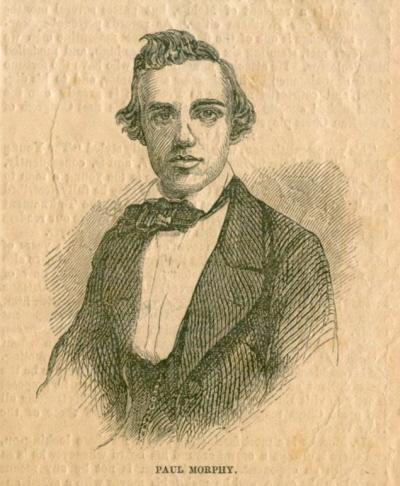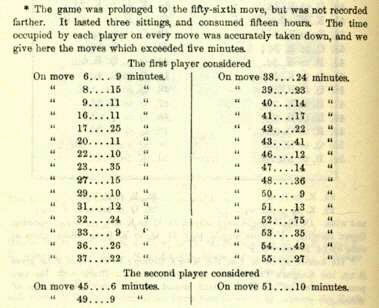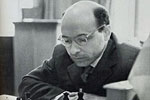Chess Explorations (74)
By Edward Winter
On page 151 of the 12 June 1885 issue of the Chess Player’s Chronicle
Hugh Browne wrote:
‘Alderman Ward was a fine, dashing player, with an irritable temper
which once bore my long delay over a move so well that I wilfully tried how
much it would bear; and when I moved at last, he only looked at his watch
beside him and said, “28 minutes”.’


Source of the above pictures: page 345 of the 31 October 1857 issue of Frank
Leslie’s Illustrated Newspaper (C.N. 7394).
A number of C.N. items have discussed instances of lengthy reflection (or,
at least, lengthy consumption of time) before a move has been played. A famous
case from the nineteenth century was examined in C.N. 4680, which reported that
under the heading ‘Amazing facts’ the following had appeared on
page 17 of Playing Chess Step-by-Step by Gary Lane (New York, 2004):
‘The slowest chessplayer ever was Louis Paulsen, who once thought for
11 hours over one move.’
This ‘fact’ of the ‘once’ variety would appear to be
based on a misunderstanding. The figure of 11 hours was given, regarding the
New York, 1857 tournament, on page 67 of Paul Morphy The Pride and Sorrow
of Chess by David Lawson (New York, 1976) but in a different context:
‘Undoubtedly, slow playing on the part of Paulsen was the reason for
time records being kept during his games with Morphy. Moves over five minutes
during the second game and portions of others were recorded. During the entire
second game, Morphy’s total time for moves over five minutes was only
25 minutes, while Paulsen consumed 11 hours for the same.’
The breakdown for that second Paulsen v Morphy game was given on page 246 of
the tournament book:

As shown below, page 248 of the tournament book indicated that the total duration
of the third game between Paulsen and Morphy was 11 hours, most of it consumed
by the former:

There is also the well-known anecdote about Paulsen, in play against Morphy,
sitting motionless at the board and suddenly asking whether it was his move.
Steinitz related it on page 46 of the February 1885 International Chess Magazine,
on the authority of Thomas Frère.
C.N. 4679 gave item 26 in Napier’s Amenities and Background of Chess-Play
(New York, 1934):
‘I remember seeing Showalter in a match game with Pillsbury brood 45
minutes over a fourth move. It was a Ruy López. Afterwards there came the
explanation. “The cigar was good; and I thought that long looking might
uncover some better move and sequel than those used.”’

Jackson Whipps Showalter
C.N. 4679 also mentioned two instances of long thought by Wolfgang Uhlmann
(1 hour 40 minutes and 1 hour 50 minutes), as related on page 351 of The
Life and Games of Mikhail Tal (New York, 1976), or page 336 of the London,
1997 edition.
Page 32 of Kings, Commoners and Knaves referred to a short match in
New York between Důras and Kupchik (which the former won with a score of
+2 –1 =0). It began with a game which opened 1 e4 e5 2 Nf3 Nc6 3 Nc3 Nf6
4 Bb5 Bb4 5 O-O O-O 6 d3 d6 7 Bg5 Be6 8 Ne2 Ne7 9 c3 Ba5

Here Důras thought for 58 minutes before playing 10 Ng3, and went on to
win.
Source: American Chess Bulletin, October 1913, page 233.

Oldřich Důras
C.N. 6119 gave this extract from pages xix-xx of the Preface by Benjamin M.
Anderson Jr to Capablanca’s A Primer of Chess (New York, 1935):


The passage was discussed in C.N.s 706 and 1177 (see pages 117-118 and 263
of Chess Explorations), as well as C.N. 6118. For the game in question
we can still offer only one candidate: Marshall v Maróczy, Lake Hopatcong, 1926.
(As mentioned in C.N. 5991, Anderson was in Lake Hopatcong at the time.) The
game began 1 e4 e6 2 d4 d5 3 Nc3 Nf6 4 e5 Nfd7 5 Qg4 c5.

Géza Maróczy
‘In the 11th game of their match in 1927 for the world’s championship,
Capablanca took two hours on one move, and Alekhine took an hour and three-quarters
for his reply.’
C.N. 2344 (see page 345 of A Chess Omnibus) noted that the above claim
appeared, in more or less identical wording, on page 39 of Irving Chernev’s
Curious Chess Facts (New York, 1937), page 101 of the same author’s
Wonders and Curiosities of Chess (New York, 1974) and page 100
of Chess by Kenneth M. Grover and Thomas Wiswell (London, 1952).
In C.N. 6315 Alan O’Brien (Mitcham, England) noted that in another match-game,
the 28th, this position arose:

Alekhine played 41 Nef4 and wrote:
‘The text move was sealed and it took me an hour and 50 minutes to
consider it, the record length of time for this match.’
The above is the English translation on page 199 of On the Road to the World
Championship 1923-1927 (Oxford, 1984). See too pages 205 and 469 respectively
of the original German and French editions of Alekhine’s book (Auf
dem Wege zur Weltmeisterschaft and volume two of Deux cents parties d’échecs).
After 41...Rb3 42 Ra7 Kd8 43 g3 Alekhine reported that Capablanca thought for
40 minutes before offering a draw, which was accepted.
According to page 2 of Crítica, 30 November 1927 Alekhine took four
hours and two minutes for the entire game, Capablanca’s total being two
hours 30 minutes. The London
Rules, under which the match was played, specified that on each play-day
the session would last five hours and that the time-limit was 40 moves per two
and a half hours.
Making all these ‘facts’ compatible with each other is far from
easy.

C.N. 4632 quoted from a column by G.
Koltanowski on page 3 of Chess Digest Magazine, March 1969:
‘David Bronstein is known to take a long time before making his first
move. In Berlin’s Lasker Memorial, he hadn’t yet made his first
move when Vassikoukov [sic] mated Zaitzev at the 15th move.’
This refers to a tournament in 1968. Apart from the consideration that the
mate in question would have come at move 16, not 15, we wondered what facts
were available regarding the story. In C.N. 4639 Alan McGowan (Waterloo, Canada)
responded:
‘The tournament book (Internationales Dr.-Emanuel-Lasker-Gedenkturnier
1968), published by the Deutscher Schachverband der DDR)
shows that the game below (game 60, on page 61) was played in round
eight:
Evgeny Vasiukov – Alexander Zaitsev
East Berlin, 25 November 1968
Caro-Kann Defence
1 e4 c6 2 d4 d5 3 exd5 cxd5 4 c4 Nf6 5 Nc3 Nc6 6 Nf3 Bg4 7 cxd5 Nxd5 8
Qb3 Bxf3 9 gxf3 e6 10 Qxb7 Nxd4 11 Bb5+ Nxb5 12 Qc6+ Ke7 13 Nxb5 a6 14 Nd4
Nb4 15 Bg5+ Resigns.
The time used by each player is shown as 0.50 for White and 0.24 for Black.
The game Csom v Bronstein was played in the same round (game 61 in the
book, also on page 61):
István Csom – David Bronstein
East Berlin, 25 November 1968
Caro-Kann Defence
1 e4 c6 2 Nf3 d5 3 Nc3 g6 4 d4 Bg7 5 Be2 dxe4 6 Nxe4 Bf5 7 Ng3 Bg4 8 c3
Bxf3 9 Bxf3 Nf6 10 O-O O-O 11 Re1 e6 12 Bg5 Nbd7 13 Ne4 Drawn.
The time used by each player is shown as 0.50 and 1.00.
The introductory notes for the round give the following comments:
“K.o. im Caro-Kann
Mit Wasjukow – Saizew (Nr. 60) gab es die einzige Grossmeisterpaarung
des Tages. Aber schon nach 74 Minuten gehörte diese Partie der Turniergeschichte
an. Auf einer schachlichen Sprintdistanz über 15 Züge, die leider auch in
diesem Wettstreit zur Remisspezialdisziplin erkoren wurde, kam Ewgeni Wasjukow
als Sieger ins Ziel. Noch ehe die Kapitulation erfolgte, hatte es sich im
Saal herumgesprochen: Saizew ist in zwei Zügen matt!! ‘Kaum zu glauben’,
bemerkten Kiebitze. “Nicht solide”, meinte Grossmeister Flohr.
Niemand hatte ein solches Ende ahnen können. Die Partie verlief bis zum
12. Zug in theoretischen Bahnen. Dann setzte Wasjukow ungewöhnlich fort
(13 Sb5:). Auf unerschlossenen Pfaden galt es sich nun zurechtzufinden.
Zwei Züge danach geschah bereits der tödliche Fehltritt (14...Sb4??), und
Wasjukow fügte den Raritäten eine weitere Mattminiatur hinzu.
Allerdings fanden sie weit weniger Beachtung, weil die Würze hier nicht
in der Kürze lag und manches überhaupt ohne Salz gekocht war. Csom –
Bronstein (Nr. 61) zeigten die wenigsten Züge.”’
We are still seeking corroboration, or otherwise, of the statement by Koltanowski
quoted in C.N. 4632. Other little-known examples of ‘long ponderings’
will also be welcome.
С большим
удовольствием
мы предлагаем
вниманию российских
любителей шахмат
перевод одной
из наших статей:
Сабуровы.
Submit information
or suggestions on chess explorations
All ChessBase articles
by Edward Winter

Edward Winter is the editor of Chess
Notes, which was founded in January 1982 as "a forum for aficionados
to discuss all matters relating to the Royal Pastime". Since then, 7,400
items have been published, and the series has resulted in four books by Winter:
Chess
Explorations (1996), Kings,
Commoners and Knaves (1999), A
Chess Omnibus (2003) and Chess
Facts and Fables (2006). He is also the author of a monograph on Capablanca
(1989). In 2011 a paperback
edition was issued.
Chess Notes is well known for its historical research, and anyone browsing
in its archives
will find a wealth of unknown games, accounts of historical mysteries, quotes
and quips, and other material of every kind imaginable. Correspondents from
around the world contribute items, and they include not only "ordinary readers"
but also some eminent historians – and, indeed, some eminent masters. Chess
Notes is located at the Chess
History Center. Signed copies of Edward Winter's publications are
currently available.




































